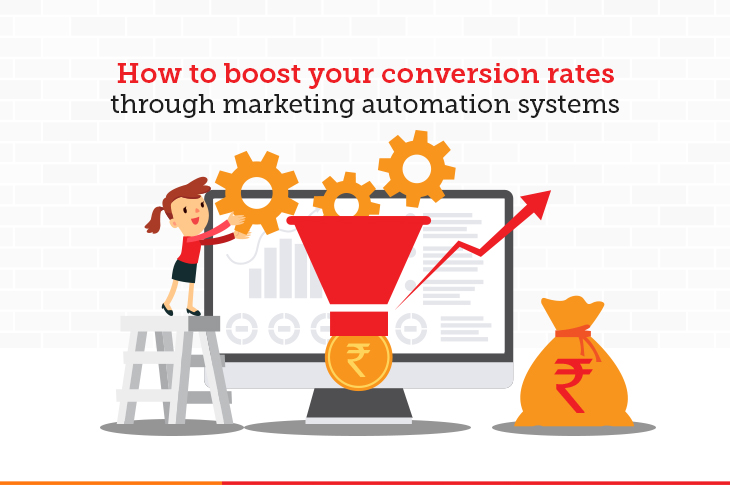Leveraging Marketing Automation to Boost Conversion Rates

Imagine you’re a college student who runs a small business dealing in handmade soaps. Initially, you might get 10-12 orders a week. To add a personal touch, you include a handwritten thank-you note with the soaps you send out to customers. They love it. The business grows and orders go up to 100 soaps a week. Due to the increased work, you find it impossible to write those notes yourself. So you rope in your best friend. She copies your handwriting, writes the notes dutifully, and even throws in a few special touches, such as wishing regular customers on their birthdays or informing them when their favorite soaps are in stock. Your customers are delighted and your business booms!
This, in simple terms, is what a marketing automation strategy would do.
As digital-first businesses become the norm, most organizations, irrespective of size and industry, are leaning on technology and using it to improve all aspects of their business. This includes core functions like sales and marketing. According to Gartner’s 2020 CMO Spend Survey, investments in marketing technology and digital channels will see the biggest allocations in 2021.
But why automation? Automation, especially in marketing, uses technology to create personalized interactions for customers and free marketers from the drudgery of routine and repetitive tasks. It can also aid in lead scoring, error detection, management of marketing performance, and efficient reporting.
Some studies suggest that implementing marketing automation can, on average, lead to a 451% rise in qualified business leads. No wonder Forbes has classified accelerated adoption of automation as one of the biggest marketing trends of 2021.
How can marketing automation improve conversion rates?
As a first step, businesses need to optimise their website for conversions through fast page loads, less clutter, strategically placed conversion elements, testimonials, etc.
Once done, the following marketing automation strategies can help improve conversion rates:
- Personalized emails: As per reports, email message personalization is the prime tactic used by marketers to expand conversion. By assessing your customer interest, it is easy to curate an email to grab the customer’s attention and trigger a conversion. However, use a relatable subject line and address the customer by the first name to create a more personalised experience. Use customer demographics, past purchases and online behaviour to offer targeted products. Leverage dynamic content and limit yourself to only two-three personalised emails per customer.
- Categorize mailing list: Segment your mailing list and send emails relevant to the customer’s age, gender and location. Understand their email history, website activity, online behaviour and accordingly, send them pertinent emails and offers. As per a report, click-throughs are 100.95% higher in segmented emails than otherwise. Further, segment your consumers based on their purchase amounts and level of engagement. Send more emails to those who have a high level of engagement and lure high-worth customers with cross-selling and up-sell opportunities.
- Activate triggers: A major benefit of marketing automation is the immediacy of response. Set up triggers by using the if-then logic and reach your customers more effectively. Triggers or kick-off automation helps you to customize customer experience and improve conversion. Use triggers to send welcome and thank you emails, display a purchase confirmation message, remind customers of pending or abandoned orders, etc.
- Create an omnichannel strategy: Use marketing automation to provide your customers with a seamless experience across all marketing channels. Work to unite your email campaigns and newsletters across platforms, amalgamate your CRM system, integrate your social media, website and landing pages.
- Form defined workflows: Deploy marketing automation to wisely plan your customer journey. Create workflows that are triggered when specific conditions are met or certain customer behaviour is observed. You could set up workflows for the welcome, post-purchase follow-up, re-engagement, loyalty programme, content and more.
- Use lead scoring: Marketing automation helps in lead scoring, which as per 68% of highly effective and efficient marketers is a top revenue contributor. Lead scoring can help you decide which customer has the potential for conversion into an actual buyer, enabling you to invest more time in the target. By evaluating the contact interest and level of engagement, qualify the lead as ‘sales-ready’ or initiate a one-to-one communication. Use parameters like pages visited, number of visits, email engagement, social media activity, etc., to score leads.
By leveraging marketing automation, you can improve business efficiency and get higher conversion rates. Precisely planned and automated customer journeys help to enhance the overall experience, thereby, increasing the chances of conversion.
Sources:
https://nugrowth.com/lead-scoring-benefits-and-stats/
https://www.wordstream.com/blog/ws/2017/06/29/email-marketing-statistics
Contributors: Rajitha Menon, Preeti Mishra and Swapnil Adsul
